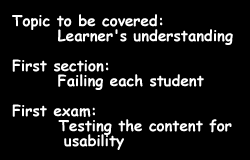 Yesterday I read this PDF and then reflected on how that relates to immersion and unconscious learning. I quickly made connections to the empowerment of learners and the desirable effects of instruction on learners. The metaphor of "reversing" conventional instruction came to mind soon after.
Yesterday I read this PDF and then reflected on how that relates to immersion and unconscious learning. I quickly made connections to the empowerment of learners and the desirable effects of instruction on learners. The metaphor of "reversing" conventional instruction came to mind soon after. Conventional instruction disempowers the learner. When conventional instruction is reversed, the learner is empowered, the outcomes improve and the long term effects are beneficial. The learners are shown respect, put in the driver's seat and given final say in what they understand.
Reversed instruction starts with "the links, not the nodes". Never mind what is going to be learned. Forget learning objectives clearly stated at the start. Assume no content is going to be delivered that could create in a new node in the learners' cognitive networks. Simply start with each learner's current understanding. Make the "uneducated grasp" the topic of study. Explore how that understanding is already linked to the ways the learner handles situations. Discover the context where the learner uses the understanding to explain, diagnose, solve or take action. Come across as pulling for the learners.
Reversed instruction then fails each learner. Never mind waiting until after the test. Forget basing the failure on some objective grading system. Give the learner an experience of their current understanding failing to function adequately. Set the learners up to realize their explanation excludes significant discrepancies, their diagnosis mistakes symptoms for a different cause, their solutions backfire or the actions do more harm than good. Give their current understanding "a bad name"
Reversed instruction then threatens to abandon the learners. Forget giving them something for their money. Never mind keeping up your half the bargain. Suggest that each learner is far more likely to keep using their current understanding than to make any change. Predict that no change in understanding will happen by delivering to them more content, expertise or scientifically validated findings.
Reversed instruction follows this "takeaway" with the presentation of the "educated understanding" that will likely be rejected. Show how it functions. Run through the different ways it explains phenomena, diagnoses symptoms, solves problems and guides actions.
Reversed instruction then puts the "educated understanding" to the test. Never mind testing the students. Forget testing for comprehension. Give the learners the power to test this new "educated understanding". Set them up to evaluate it's worth, utility and functionality. Let them find out if it works for them. Put the understanding to the test to see if they can succeed with it in use.
Reversed instruction then clarifies the learners' choice. Forget reviewing the material that has been covered. Never mind formulating an action plan to implement the advice in the field. Simply handoff the final choice. Show how the educated understanding will only be adopted if it keeps the learners out of trouble and makes them more likely to succeed. If it's useless information, they'll forget it. If it's too difficult to apply, it's gone. If it's misleading and easily bungled, their established understanding will get relied upon until further notice.
Reversed learning works with the unconscious mind. It creates an immersion in danger where something has got to change. The issue is their understanding in use, not new information. The change is set up to occur within the learners. Nothing will be adopted that fails to contribute to personal survival and success. If it works personally, the unconscious will take it on as a new habit. Unconscious competence will be the result.
No comments:
Post a Comment